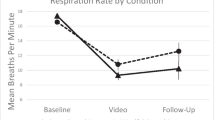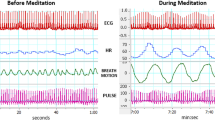Abstract
Objectives
The commentary offers a critical examination of the suggestion that religious or spiritual identity moderates the impact of mindfulness-based practices.
Method
The critical examination of Hunt et al. (Mindfulness, 12(11), 2743–2753, 2021) by surveying problems in research methodology and interpretation of the results.
Results
Several methodological limitations were identified and related to the sample size, application of statistical procedures and interpretation of the results.
Conclusions
The results challenge the suggestion that spirituality moderates the impact of mindfulness-based practices, in particular of mindfulness of breathing compared to diaphragmatic breathing, evident in a lack of significant moderating effect of spirituality on heart rate variability, and of the proposal of relating this to a supposed misunderstanding of Buddhism as a religious tradition.
Similar content being viewed by others
Avoid common mistakes on your manuscript.
The critical examination of Hunt et al. (2021) begins by surveying problems in the research methodology, followed by evaluating the proposed conclusions regarding a moderating impact of spirituality on mindfulness-based interventions.
Research Methodology
Hunt et al. (2021) investigated the effects of mindfulness of breathing and of diaphragmatic breathing in a small student sample (n = 48) using heart rate variability (HRV) as an outcome measure while controlling for spirituality. The authors used ANCOVA with 2 groups and one covariate that requires a minimum sample size of 400 participants to detect a small effect size of 0.25 under p = 0.05 with 95% certainty (Faul et al., 2007). Despite the small and underpowered sample size and the apparent pilot nature of the study, the authors came to the conclusion “that spirituality may moderate the impact of mindfulness-based interventions (MBIs) in the American context.” Needless to say, the design of Hunt et al.’s (2021) pilot study cannot be considered a representative of all MBIs that employ a large variety of interventions, using generally larger and more representative samples and measures that vary on robustness (Krägeloh et al., 2019). Hunt et al.’s (2021) study has also a number of other significant limitations that restrict both generalizability and interpretability of their findings in several ways.
The proposed conclusion is not supported by their results (F(4,46) = 3.69, p = 0.06) with p-value above the generally acceptable cut-off point of 0.05, which the authors still interpreted as “marginally significant.” Reporting non-significant p-values as approaching significance or being marginally significant is a problem, because it may contribute to false positives (i.e., null findings could be misattributed as true effects) and less replicable mindfulness research. In addition, omnibus tests such as ANOVA or ANCOVA need to be conducted first of all to avoid type I error due to multiple testing, which was not the case in Hunt et al. (2021), as they conducted and reported paired t-tests straight upfront, thus increasing probability to find a significant result just by chance. Normally, if an omnibus test is not significant, a researcher is supposed to stop there and report non-significant results, which is considered as the best practice if parametric statistics is involved.
Typically, studies assessing autonomic nervous system (ANS) function using physiological measures such as HRV require participants to refrain from beverages containing caffeine, such as tea, coffee, or other energy drinks, for at least two hours before the assessment, because such stimulants significantly affect ANS (Medvedev et al., 2015). There is no mention in the article that Hunt et al. (2021) controlled for this important confound. Follow-up assessment was confounded by the fact that participants were asked to practice the same exercises they had learned during the intervention. This means that follow-up was another phase of intervention and there is no way to establish whether there was any enduring effect of the intervention on participants.
Moreover, Hunt et al. (2021) used the standard deviation of the inter-beat interval of normal sinus beats (SDNN) as their primary outcome measure, which is primarily regulated by respiratory sinus arrhythmia (RSA), directly linked to breathing rates during short-term recording (Shaffer & Ginsberg, 2017). This means that their results may only reflect an immediate effect of changing breathing patterns, rather than an overall impact of the intervention at follow-up. Research suggests that more accurate estimates of SDNN are obtained when computed over 24 h (Grant et al., 2011).
Hunt et al. (2021) used the Beliefs and Values Scale (King et al., 2006) to measure spirituality, which is generally a loosely defined construct. As the authors noted in their article, this “may or may not be linked to religious beliefs.” In fact, King et al. (2006) stated that “people had difficulty defining spirituality,” and then identified the following themes: “(1) a search for meaning in the world, in their relationships with others and in their personal circumstances; (2) ideas on God, religion, meditation, prayer, and life after death; and (3) their reactions to the world around them, particularly the beauty or grandeur of nature (p. 420).”
Due to the difficulties in defining spirituality, King et al. (2006) decided to avoid this term altogether and defined the latent construct as the Beliefs and Values Scale. As a result, there is a validity issue in Hunt et al.’s (2021) claims on the effect of “spirituality,” as they measured the overall magnitude of beliefs and values, rather than spirituality per se (King et al., 2006). Moreover, major religious groups (e.g. Buddhism) were not adequately represented in the scale validation process. For example, out of 372 participants used for validating the scale, the majority were Christian and the second largest group (n = 127) were not religious at all (King et al., 2006). Therefore, the Beliefs and Values Scale cannot be considered as a valid measure of spirituality or religious identity, because it was neither defined nor validated as such a measure.
The Impact of Spirituality
Based on the above inconclusive results, Hunt et al. (2021, p. 2750) concluded that, consistent with their hypothesis, “spirituality mattered in predicting which technique worked best.” Yet, the “instructions made no mention specifically of Buddhism, Hinduism, or Yogic traditions” (p. 2746) and “there was no interaction between spirituality and condition on rating the acceptability of the approach. That is, less spiritual participants do not seem to have been consciously aware of finding the mindful breathing approach less helpful or acceptable” (p. 2748).
Given such caveats, it would be highly advisable to be cautious in drawing far-reaching conclusions. In the context of a remarkably informative study of the role of religion for mindfulness-based interventions, Palitsky and Kaplan (2021, p. 2083) commented that “the effects of an intervention’s religious framing be regarded as interactive with participant characteristics.” In other words, the impact of religious or spiritual associations may vary considerably depending on the individual practitioner’s proclivities. This makes it preferable to avoid the construal of globalizing assessments that do not accord sufficient room to such individual variations, which is all the more relevant when working with small samples.
Another and perhaps more serious problem is that Hunt et al. (2021, p. 2750) supported their assumption of a moderating effect of spirituality on MBIs by reasoning: “The categorization of ‘religion’ and their labelling as single entities (e.g., ‘Buddhism’ and ‘Hinduism’) were in fact created by European colonists during their encounters with these traditions in the eighteenth and nineteenth centuries.”
Although this is a popular idea, it involves a misunderstanding. The construction of Buddhism did not take place only in the eighteenth and nineteenth centuries but has its roots in ancient times in the Asian setting (Anālayo, 2021). In support of their assessment, Hunt et al. (2021) quoted Silk (1994). The referenced article is a review of Almond (1988), expressing criticism of this popular idea rather than endorsing it. For example, Silk (1994, p. 173) queried: “Is it really so that Buddhist scholarship ‘brought [Buddhism] into being’?” He then pointed out (p. 174): “Historically speaking, of course, Buddhists in Asia, to the extent that they have been aware of the existence of others who share their faith but manifest in a different fashion, have historically ‘created’ Buddhism all along.”
The situation thus appears to be the very opposite of what Hunt et al. (2021, p. 2750) seem to believe when asserting that: “these traditions look strikingly different when viewed from an indigenous lens. From this perspective, they are not singular religions the way European colonists interpreted them, which imply they necessitate belief and separate believers and non-believers.”
There can be hardly any doubt that the Buddhist traditions, from their outset, had an emic perception that separates believers and non-believers. Moreover, although early Buddhism has noteworthy elements of rationality and open inquiry, which continue in some form in later traditions, it is still a religious tradition that involves a form of belief in the sense of accepting teachings on trust for the purpose of embarking on meditation practice. For such reasons, it is not the case that there is “a mischaracterization of these traditions as ‘religions’ rather than pluralistic and experiential philosophies, one that is rooted in colonial interpretations” (p. 2750). When the authors “suggest the importance of decolonizing our understanding of eastern wisdom traditions,” it may appear that there is rather a need of updating the understanding of these eastern wisdom traditions first of all, so that it concords with the current knowledge in the academic fields of Buddhist Studies.
References
Almond, P. C. (1988). The British discovery of Buddhism. Cambridge University Press.
Anālayo, Bh. (2021). Superiority conceit in Buddhist traditions, a historical perspective. Wisdom Publications
Faul, F., Erdfelder, E., Lang, A. G., & Buchner, A. (2007). G* Power 3: A flexible statistical power analysis program for the social, behavioral, and biomedical sciences. Behavior Research Methods, 39(2), 175–191.
Grant, C. C., van Rensburg, D. C., Strydom, N., & Viljoen, M. (2011). Importance of tacho-gram length and period of recording during noninvasive investigation of the autonomic nervous system. Annals of Noninvasive Electrocardiology, 16, 131–139. https://doi.org/10.1111/j.1542-474X.2011.00422.x
Hunt, M., Rajagopal, T., Cerecino, F., & O’Neil, M. (2021). Mindful versus diaphragmatic breathing: Spirituality moderates the impact on heart rate variability. Mindfulness, 12(11), 2743–2753. https://doi.org/10.1007/s12671-021-01738-x
King, M., Jones, L., Barnes, K., Low, J., Walker, C., Wilkinson, S., Mason, C., Sutherland, J., & Tookman, A. (2006). Measuring spiritual belief: Development and standardization of a Beliefs and Values Scale. Psychological Medicine, 36(3), 417–425. https://doi.org/10.1017/S003329170500629X
Krägeloh, C. U., Henning, M. A., Medvedev, O. N., Feng, X. J., Moir, F., Billington, R., & Siegert, R. J. (2019). Mindfulness-based intervention research: Characteristics, approaches, and developments. Routledge.
Medvedev, O. N., Shepherd, D., & Hautus, M. J. (2015). The restorative potential of soundscapes: A physiological investigation. Applied Acoustics, 96, 20–26.
Palitsky, R., & Kaplan, D. M. (2021). The role of religion for mindfulness-based interventions: Implications for dissemination and implementation. Mindfulness, 12(8), 2076–2089. https://doi.org/10.1007/s12671-019-01253-0
Shaffer, F., & Ginsberg, J. P. (2017). An overview of heart rate variability metrics and norms. Frontiers in Public Health, 5, 258.
Silk, J. A. (1994). The Victorian creation of Buddhism. Journal of Indian Philosophy, 22, 171–196. https://doi.org/10.1007/BF01061755
Author information
Authors and Affiliations
Corresponding author
Ethics declarations
Ethical Approval
This article does not contain any studies performed by the authors with human participants or animals.
Conflict of Interest
The authors declare no competing interests.
Additional information
Publisher's Note
Springer Nature remains neutral with regard to jurisdictional claims in published maps and institutional affiliations.
Rights and permissions
About this article
Cite this article
Medvedev, O.N., Anālayo, B. Heart Rate Variability, Mindfulness of Breathing, and Religious Identity. Mindfulness 13, 54–56 (2022). https://doi.org/10.1007/s12671-021-01792-5
Accepted:
Published:
Issue Date:
DOI: https://doi.org/10.1007/s12671-021-01792-5




